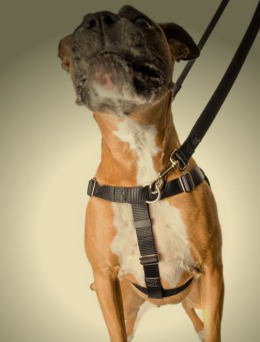March 5, 2015
This month, Kiki Yablon, KPA CTP, CPDT-KA, shares tips on making sure your dog’s harness is both comfortable and effective.
There is no perfect dog-walking equipment—especially from the dog’s perspective. Who among us wouldn’t prefer to be able to go where we want, when we want, at the speed we want?
Unfortunately, in the city, some kind of equipment is necessary. First, that’s the law. But also, because behavior is always a response to environmental conditions, it’s never 100 percent reliable. Your dog may have proven his ability to attend to you around squirrels, bikes, and funny hats—but along comes a squirrel wearing a funny hat, while riding a bike, and all is lost.
My goal is that whatever we’re using for restraint is a backup, and my job as the dog’s walking companion is to make it as unobtrusive as possible.
For most dogs, harnesses are my first choice, even if the dog can walk nicely on a flat collar. In particular, of those I’ve had experience with, I like Balance Harness by Lori Stevens (which is what I’m currently using with my own dog) and for management of pulling, the Freedom Harness by 2 Hounds Design. The modular Perfect Fit gets stellar reviews from colleagues, but I haven’t tried it. For very small dogs, I lean toward soft, vest-style harnesses.
Many others have written about why harnesses are a good choice, and I won’t spend time on that here. Instead, I’d like to talk about how to fit a harness, specifically some of the popular brands used to deter pulling in dogs who haven’t yet learned to walk on a loose leash.
Most of these harnesses have a front clip on the strap that goes across the dog’s chest. When the leash is attached to this clip, when the dog pulls, the pressure he feels encourages a turn to his side. But these harnesses are frequently fitted too loosely and/or with the chest strap too low. When the latter happens, the dogs look (and walk) a bit like they’re wearing their pants around their ankles.
How To Fit a Harness On Your Dog
Check the photo on the package. Where does the clip go, where does the differently colored strap go, where does the label show? There’s probably a good reason for that.
Adjust the strap that goes under the dog’s ribs first. Make it as long as you can.
Then adjust the strap that goes over your dog’s back, making it as short as you can. Steps 2 and 3 ensure that the chest strap has the best chance of sitting above the shoulders. The harness should not hobble your pup.

The top and bottom straps, which encircle your dog’s back and ribs, should be snug. The general rule is that you should be able to fit two fingers between the straps and the dog’s body. Looser is not necessarily more comfortable—if you wear a bra, you know what I mean.
The top and bottom straps should also form a more or less vertical line behind your dog’s shoulders. If they don’t, loosen the strap that goes across the chest.
The chest strap should not be so tight that it cuts into the dog’s body, and should not restrict shoulder movement by being too tight or too low.
Neither should it dangle loosely in front of the dog. Check to make sure your dog cannot pull a leg up and back through the chest or bottom straps, even if he rolls and wiggles around. Be especially aware of this with short-legged breeds.
If you do all of the above, and the top and bottom straps are still pulled forward, your dog’s shoulder movement is still restricted, or the front still dangles, you should consider a different size or a different harness.
Walking your newly harnessed dog.
Many dogs adjust to harnesses as quickly as they do to flat collars. Some do not. The good news is that treats can often change their minds. For each step of putting on the harness, give them a treat. If you need a visual, there are plenty of videos online! The Balance Harness and some other brands now also offer versions that snap around the neck rather than slip over the head.
Even no-pull harnesses, which make pulling less reinforcing, don’t teach your dog how to walk—that’s your job. If the dog pulls, don’t pull back. Instead, come to a soft stop and wait (provided, he’s not pulling into danger).
Take treats with you. Immediately reinforce any and all orientation, or reorientation, in your direction. This includes turns prompted by a no-pull harness—make that pressure an opportunity, rather than an aversive, for your dog.
If the equipment is fitted, and handled properly, these two steps alone will lay the foundation for a pleasant walking experience for both you and your dog.
Do you live in Chicago? Interested in dog walking services?
Contact us today at support@rover-time.com or visit our Home Page for more information!
Read more training articles and learn more about Kiki’s services at Dog Training by Kiki Yablon

Recent Comments